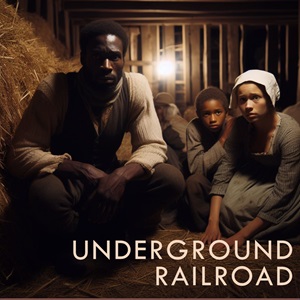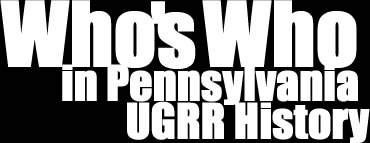


People involved with the story of Pennsylvania's Underground Railroad network, including activists, freedom seekers, station masters, conductors, financiers, lawyers, slave hunters, abolitionists, anti-slavery and pro-slavery adherents, politicians, heroes, villains, and more.
Study Areas
Who's Who in Pennsylvania's Underground Railroad
L Surnames
- LeMoyne, Dr. Francis Julius 1798 - 1879
- Location: Washington, Pennsylvania; Role: Anti-slavery activist, UGRR
activist
Documentation: William J. Switala, Underground Railroad in Pennsylvania (Mechanicsburg, PA: Stackpole Books, 2001), p. 70-71, 76-78.
Founder of the Western Abolition Society in 1824 and the Washington County Anti-Slavery Society in 1835, Dr. LeMoyne and his family also regularly hid fugitive slaves in their home in Washington, Pennsylvania. He ran for governor of Pennsylvania several times on the Liberty Party ticket.
- Leonard, Rev. William
- Location: Leonardsville (modern day Holbrook), Center Township, Greene County ; Role: UGRR stationmaster
Documentation: Brewster, R. W., "The Rise of the Antislavery Movement in Southwestern Pennsylvania," Western Pennsylvania Historical Magazine 22 (March 1939): 1-18. | Andrew J. Waychoff, Local History of Greene County and Southwestern Pennsylvania, 1975, p. 85.
- Lewis, Dr. Robert
- Location: Dover, York County ; Role: UGRR stationmaster
Documentation: John Gibson, History of York County, 1886, pp.497-500.
- Lewis, Dr. Webster
- Location: Lewisberry, York County ; Role: UGRR stationmaster
Documentation: John Gibson, History of York County, 1886, pp.497-500; William Still, The Underground Rail Road, 1872.
- Logan, Dan
- Location: Quincy Township, Franklin County ; Role: slave catchers
Documentation: G. Craig Caba, Episodes of Gettysburg and the Underground Railroad, 1998, p. 58-59, 82.
- Loney, Robert
- Location: Columbia, Lancaster County ; Role: UGRR conductor, activist
Documentation: R. C. Smedley, History of the Underground Railroad in Chester and the Neighboring Counties of Pennsylvania, 1883, reprinted 2005, pp 49, 51, 77.
- Loyer, Henry
- Location: Harrisburg; Role: Slave catcher
Documentation: Gerald G. Eggert, "The Impact of the Fugitive Slave Law on Harrisburg: A Case Study," Pennsylvania Magazine of History and Biography 109 (October 1985, 537-569).
Harrisburg constable who worked closely with United States Commissioner Richard McAllister in rounding up suspected fugitive slaves and detaining them for hearings. Loyer and several fellow constables employed questionable legal tactics in finding and handling accused fugitives. Loyer was the arresting officer in the James Phillips incident in 1852. Harrisburg citizens voted Loyer out of office in March 1853, apparently dissatisfied with his slave-catching activities. In August 1853 Loyer was tried for kidnapping in a case involving a free African American citizen. He was found not guilty.
- Lundy, Benjamin 1789 - 1839
- Location: Philadelphia; Role: Abolitionist publisher
Documentation: Appleton's Cyclopedia of American Biography, edited by James Grant Wilson, John Fiske and Stanley L. Klos. Six volumes, New York: D. Appleton and Company, 1887-1889 and 1999. Reproduced on Famous Americans.net http://famousamericans.net/benjaminlundy/
Although he spent only a relatively short time in Pennsylvania, Benjamin Lundy's legacy was the abolitionist newspaper The National Enquirer, begun in 1836 and published by him until 1838, when a mob burned his equipment along with Pennsylvania Hall. When Lundy moved to Illinois in 1839, The National Enquirer was taken over by John Greenleaf Whittier, and renamed the Pennsylvania Freeman. In 1840 the Pennsylvania Freeman became the official newsletter of the Pennsylvania Anti-Slavery Society, and was edited by James Miller McKim. Lundy also had a brief professional association with William Lloyd Garrison, in 1829.
- Lyne, Henry
- Location: Harrisburg; Role: Slave catcher
Documentation: Gerald G. Eggert, "The Impact of the Fugitive Slave Law on Harrisburg: A Case Study," Pennsylvania Magazine of History and Biography 109 (October 1985, 537-569).
Harrisburg's high constable who worked closely with United States Commissioner Richard McAllister in rounding up suspected fugitive slaves and detaining them for hearings. Lyne and several fellow constables employed questionable legal tactics in finding and handling accused fugitives. Lyne was involved with the infamous William Smith killing in Columbia. Harrisburg citizens voted Lyne out of office in March 1853, apparently dissatisfied with his slave-catching activities. He ran for constable in subsequent years, but was never returned to office.
Rev. M. Leonard used the cellar of his farmhouse to shelter fugitive slaves, probably received from Mount Morris. Received fugitives from John Adams, in Center Township.
Dr. Robert Lewis operated an UGRR station in Dover, Pennsylvania, receiving fugitives from Adams County and forwarding them to his father, Dr. Webster Lewis, in Lewisberry. Gibson recounts an incident that happended in 1830: "About the same time 'a slave- driver' snapped a pistol at Dr. Robert Lewis, in the village of Newberry, and then fled. His pistol did not discharge.
Dr. Webster Lewis operated an UGRR station in Lewisberry, Pennsylvania, receiving fugitives from his son, Dr. Robert Lewis, in Dover, and forwarding them either to a station near Boiling Springs, most likely Daniel Kaufman, or across the Susquehanna River at Middletown Ferry. Gibson reports "Many of them remained at Middletown, and were employed in the lumber yards. Their descendants are now there." Lewisberry had a local abolition society.
William Still reports that Dr. Lewis often worked with William Wright, Joel Fisher and William Yocum.
Dan Logan was an infamous slave catcher who operated in and around the mountains of Franklin County, particularly around Mt. Alto and Funkstown. He was said to keep captured slaves chained to the floor in the attic of his house He gained fame from catching John Brown conspirator and raider John Edwin Cook. He sometimes worked with another man, Claggett Fitzhugh, of Quincy.
Smedley describes Robert Loney as "that well known colored man on the Susquehanna...who ferried fugitives across the river in the night at various places below Columbia." Loney was one of the large group of manumitted slaves from Henrico County, Virginia who arrived and settled in Columbia in 1819, and formed the base of its large and well established African American community. Loney worked closely with Jonathan Mifflin and William Wright, and fugitives from this arrangement were often sent to Daniel Gibbons, near Lancaster.
